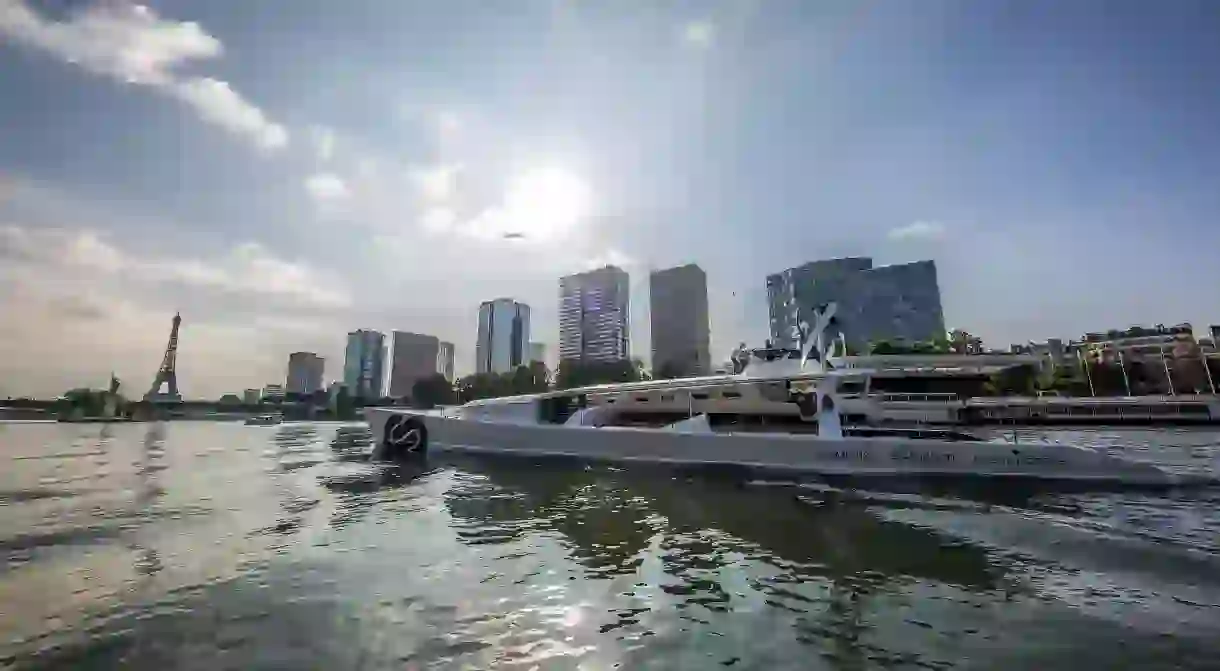A Self-Fueling Boat Has Left Paris For a Six-Year Trip Around the World

This weekend, the Eiffel Tower provided the starting post for the Energy Observer’s epic six-year voyage around the globe. Transformed by a stellar team of 50 engineers, designers, and naval architects, this former champion racing catamaran now powers itself with a mixture of solar and wind energy and hydrogen derived from the electrolysis of sea water.
Berthed at the Port du Gros Caillou on the Left Bank for ten days, having left its home port in Saint-Malo at the end of June, the Energy Observer looked every cent of the €5 million ($5.25 million) it cost to create. At 30.5 meters (100 feet) in length, it is equipped with 120 square meters of solar panels and two vertical axis wind turbines. These clean energy sources will keep the boat going during the day and provide power for the two electric motors that are needed to produce its night time supply of hydrogen from sea water electrolysis. The crew can also use a kite sail for additional propulsion.

The magnificent vessel has known many names in its time. It first took to the water in 1983 under the title Formule Tag and it went on to have a successful career in open-sea sailing races. The highlight of which came in 1994 when, as Enza New Zealand, it won the prestigious Jules Verne Trophy for the fastest yacht of any kind to circumnavigate the planet, doing it in a then-record time of 74 days, 22 hours, 17 minutes, and 22 seconds—it still holds the eighth position on the all-time leader board. Now, it is looking to set a new kind of record as the first boat to sail around the world solely on hydrogen and renewable energies.
“Paris, the city of light, was the first of 101 Energy Observer stops,” explained Jérôme Delafosse, a naval explorer and expedition leader. “We are proud of the incredible hospitality of the public, businesses, and decision-makers, they are the first members of our community, the pioneers of a cleaner future.”

The next 100 calls will be at capital cities, environmentally sensitive areas, and major sailing events in 50 countries. The exact route will be planned along the way and the expedition’s website allows for people and organizations engaged in the creation of an emissions-free future to offer to host the boat along its journey.
“There is no silver bullet to fight against global warming: there are solutions, which we must learn to make work between them,” states Victorien Erussard, a former offshore racer and the boat’s captain, on the website. “This is what we do with Energy Observer: to bring together the energies of nature, but also of our society, bringing together around this boat, the know-how of companies, laboratories, start-ups, and institutions.”

It’s impossible to say what discoveries and developments will have been made by the time the Energy Observer passes by the Eiffel Tower again in 2023 but it’s sure that the ambitious nature of this project will allow it to serve as a model and inspiration to decision-makers, inventors, and eco-conscious citizens everywhere.
https://youtu.be/NR_LxKL_af0?list=PL5qDwHTDF62fYLE9qAqGFWAVYg_vlRKxq













